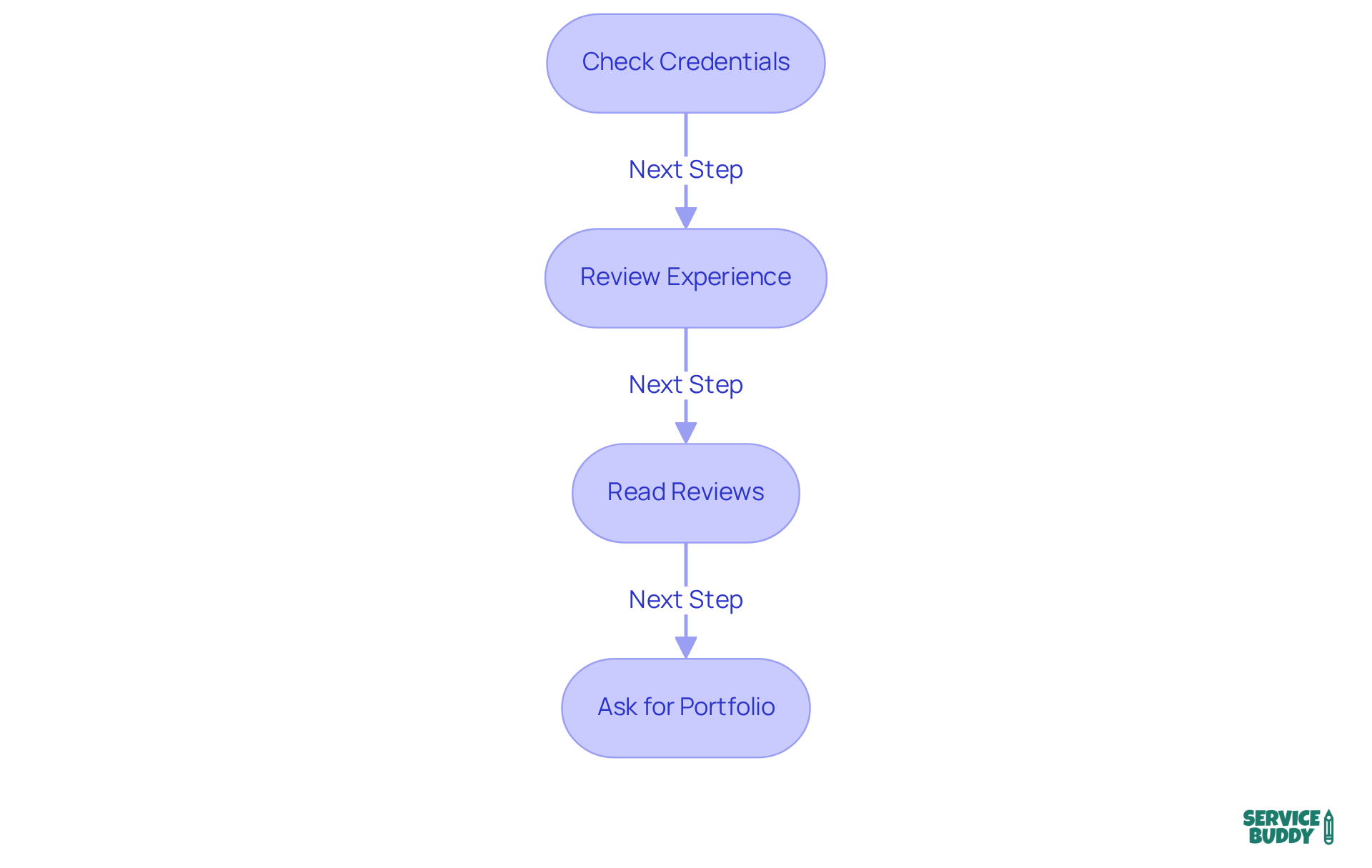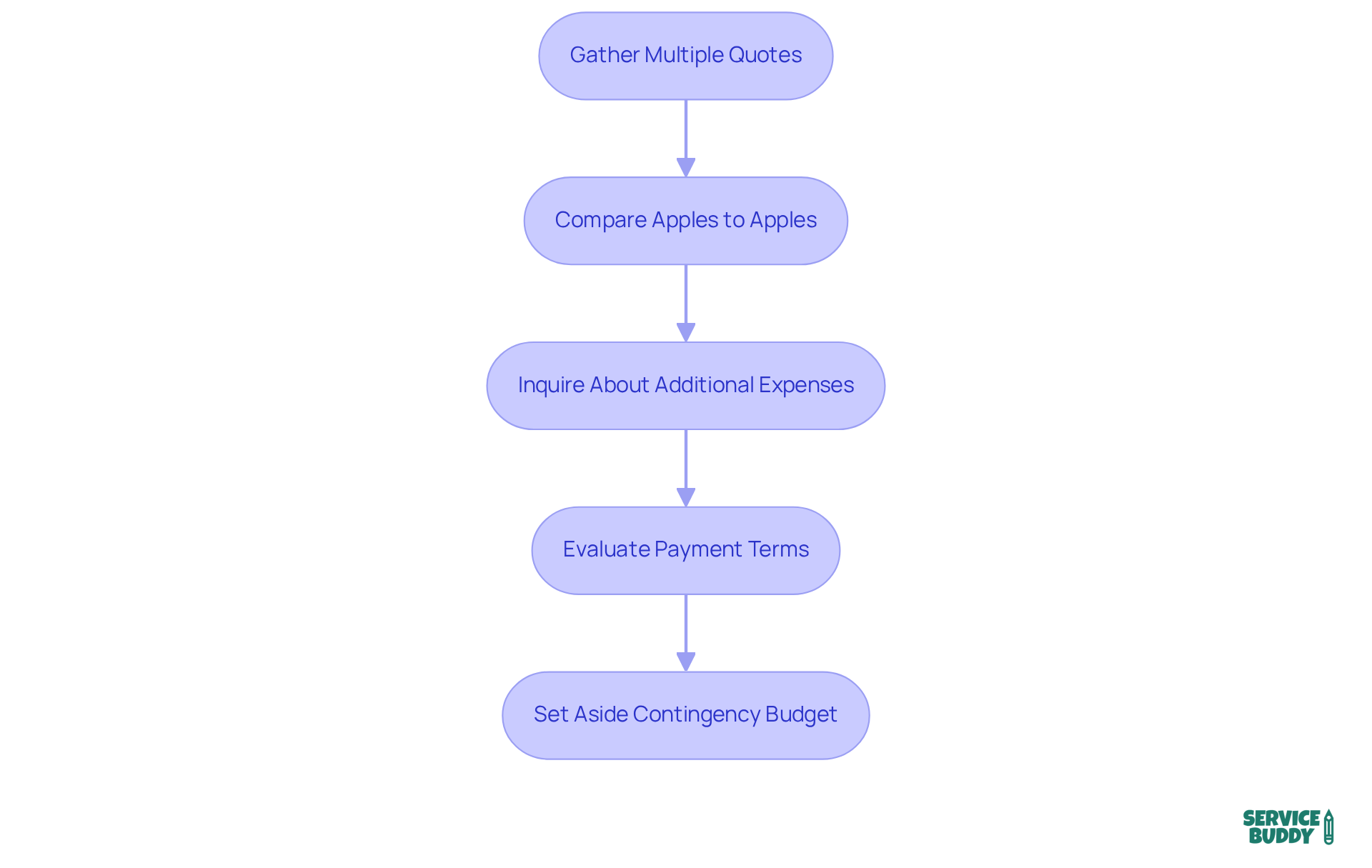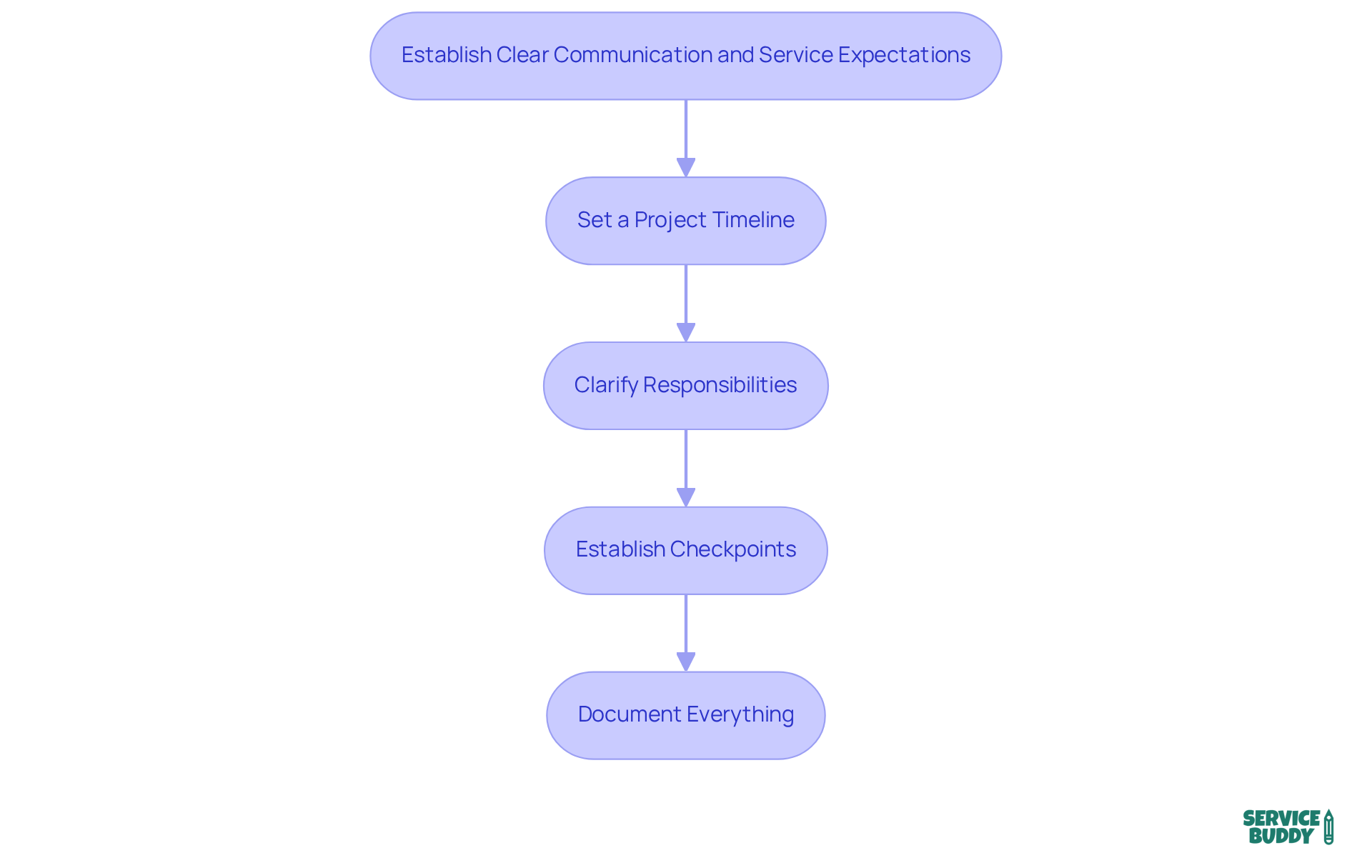Overview
To find the best floor installers near you, it is essential to:
- Assess your flooring needs
- Evaluate installer qualifications
- Request multiple quotes
- Establish clear communication throughout the process
Begin by understanding your space and style preferences; this foundational step is crucial for a successful installation. Next, check the credentials and experience of potential installers, ensuring they meet industry standards. Comparing costs from various installers will help you make an informed decision, while maintaining open dialogue throughout the process fosters trust and clarity.
This systematic approach not only enhances your confidence in the choice you make but also sets the stage for a successful flooring project.
Introduction
Finding the right floor installer can often feel like navigating a complex maze, given the multitude of options available. Homeowners not only seek quality craftsmanship but also desire the assurance that their investment will enhance both the beauty and functionality of their spaces. With numerous factors to consider—from assessing specific flooring needs to evaluating the qualifications of potential installers—how can one ensure the best choice is made?
This guide unpacks the essential steps to finding reliable floor installers, empowering readers to transform their homes with confidence.
Identify Your Flooring Needs and Options
- Assess Your Space: Begin by evaluating the designated area for installation. Key factors to consider include foot traffic, moisture levels, and the existing decor. High-traffic zones such as hallways and kitchens benefit from durable materials like laminate or porcelain tile, known for their resistance to wear and moisture. Conversely, softer options like carpet are ideal for bedrooms, providing comfort and warmth.
- Determine Your Style Preferences: Reflect on the aesthetic you wish to achieve. Are you drawn to a modern ambiance with sleek tiles, or do you prefer the rustic charm of hardwood? Collecting samples or images of surface designs that resonate with you can clarify your vision and guide your choices.
- Consider Practical Needs: Identify specific requirements that may influence your flooring selection. Hypoallergenic substances are vital for sensitive individuals, while water-resistant alternatives are crucial for bathrooms and kitchens. This targeted approach streamlines your decision-making process.
- Set a Budget: Establish a comprehensive budget that encompasses not only the cost of supplies but also installation and ongoing upkeep. This financial framework assists you in making informed choices and avoiding overspending, ensuring you select materials that satisfy both your aesthetic and practical needs.
- Explore Popular Surface Options for 2025: As you assess your choices, consider the most favored surface options for 2025. Porcelain tile stands out for its durability and aesthetic appeal, making it suitable for high-traffic areas. Laminate surfaces offer a cost-effective option resembling hardwood while providing remarkable scratch resistance, with installation expenses ranging from $3 to $10 per square foot. Additionally, luxury vinyl is gaining traction for its water resistance and ease of maintenance, making it a practical choice for busy households.
- Top Surface Choices for Busy Spaces: When selecting surfaces for high-traffic areas, prioritize . Porcelain tile, laminate, and commercial-grade carpets are excellent choices, as they resist wear and maintain their appearance over time. As tile expert Wang states, "Porcelain tile doesn’t wear out, scratch, or stain... Its color doesn’t fade, it’s waterproof, and it’s surprisingly slip-resistant, even when wet." These resources not only enhance the functionality of your area but also contribute to a welcoming ambiance.

Evaluate Installer Qualifications and Reputation
- Check Credentials: It is imperative to ensure that potential floor installers near me hold the necessary licenses and certifications. Look for affiliations with esteemed organizations such as the National Wood Flooring Association (NWFA) or the Certified Flooring Installers (CFI) program. INSTALL certified contractors offer an additional warranty on their work, completely free of charge, demonstrating a commitment to quality and providing crucial warranty protection to safeguard your investment.
- Review Experience: Inquire about the installer's experience with the specific type of surface you have selected. Ask how many similar projects they have completed and request references from past clients. Floor installers near me can complete surface setup more efficiently than do-it-yourself attempts, minimizing downtime. Their extensive experience is essential for managing the intricacies of various material types and ensuring correct installation methods. As Greg Walker, Manager at Lifetime Flooring, aptly states, "When installing new floors, experience matters. It’s about knowing the right way to do it and how to make your floors look natural and last a long time."
- Read Reviews: Leverage platforms like Yelp, Angi, or Houzz to explore customer reviews and ratings. Pay particular attention to feedback regarding the installer's reliability, communication, and quality of work. Homeowner satisfaction tends to be higher when installations are executed by certified experts, like floor installers near me, as they adhere to industry standards and best practices. significantly influences customer satisfaction with floor installations.
- Ask for Portfolio: Request to view a collection of prior projects. This will provide a visual understanding of their work quality and style, aiding you in determining if they meet your expectations. Successful surface installation projects often highlight the expertise of certified installers, reflecting their ability to deliver high-quality results that enhance the overall aesthetic and value of your space. Notably, homes with professionally installed hardwood floors can see their value increase by as much as 2.5%.

Request Quotes and Compare Installation Costs
- Gather multiple quotes by reaching out to at least three different floor installers near me for detailed estimates to ensure you make an informed decision. Each quote should provide a comprehensive breakdown of expenses, including supplies, labor, and any additional charges. This practice not only aids in understanding market rates but also establishes a basis for comparison. For instance, the typical expense for a living room setup ranges from $1,500 to $4,000, assisting homeowners in planning for larger spaces.
- Compare Apples to Apples: When evaluating quotes, ensure they pertain to the same scope of work. Pay close attention to variations in material quality, assembly techniques, and warranty offerings. While the ranges from $3 to $12 per square foot, significant differences can arise based on the type of material and the complexity of the task.
- Inquire About Additional Expenses: It is crucial to ask about any potential extra charges that may not be included in the initial estimate. This could involve the removal of old flooring, which typically ranges from $1.50 to $3.50 per square foot, necessary subfloor repairs, or travel fees. Understanding these factors can greatly enhance your budgeting accuracy, as additional expenses can elevate your total budget by 10-20%.
- Evaluate Payment Terms: Review the payment terms outlined in each quote with care. Look for transparency regarding deposits, payment schedules, and accepted payment methods. Hiring floor installers near me often includes warranty coverage and skill, helping to avoid unforeseen financial issues later in the project and ensuring a smoother execution experience. Additionally, consider setting aside a contingency budget of around 10% for unexpected challenges.

Establish Clear Communication and Service Expectations
- Set a Project Timeline: Collaborate with your installer to establish a realistic timeline, incorporating specific start and completion dates. Effective communication regarding timelines is crucial; it can prevent delays and unexpected costs in home renovation projects. Industry insights reveal that transparent schedules are essential for successful setups, ensuring both parties are aligned on expectations. Remember, customer satisfaction is paramount for contractors, making communication vital for successful home renovations.
- Clarify Responsibilities: Clearly define the roles and duties of everyone involved in the setup process. Discuss who will oversee the removal of old flooring, prepare the subfloor, and manage cleanup after the setup. This clarity prevents misunderstandings and ensures all tasks are accounted for, contributing to a smoother workflow.
- Establish Checkpoints: Schedule regular check-ins throughout the installation to address any concerns or changes that may arise. Maintaining open lines of communication allows for timely adjustments, fostering a collaborative environment that is vital for project success. Regular updates keep the project on track and enhance team cohesion.
- Document Everything: Keep a comprehensive written record of all agreements, including quotes, timelines, and any modifications made during the project. Effective documentation serves as a crucial paper trail that prevents disputes and ensures accountability among stakeholders. This practice is essential for maintaining clarity and down the line.

Conclusion
Selecting the right floor installers is an essential step in achieving a successful flooring project. By clearly understanding your specific needs and preferences, evaluating installer qualifications, and maintaining open lines of communication throughout the process, homeowners can make informed decisions that enhance both the aesthetic and functional aspects of their spaces.
This article presents a thorough approach, beginning with an assessment of flooring options tailored to your space and style. It then guides you through the evaluation of potential installers based on their credentials, experience, and customer feedback. Furthermore, it underscores the necessity of obtaining multiple quotes to compare costs and ensure pricing transparency. Establishing clear timelines and responsibilities is crucial in contributing to a seamless installation experience.
Ultimately, dedicating time to research and communication not only results in a beautifully installed floor but also safeguards your investment and peace of mind. By adhering to these guidelines, homeowners can confidently navigate the process of selecting the best floor installers, ensuring that their renovation projects align with both their expectations and budgetary constraints.
Frequently Asked Questions
How should I assess my space before choosing flooring?
Begin by evaluating the designated area for installation, considering factors such as foot traffic, moisture levels, and existing decor. High-traffic zones like hallways and kitchens benefit from durable materials, while softer options like carpet are ideal for bedrooms.
What style preferences should I consider when selecting flooring?
Reflect on the aesthetic you wish to achieve, whether it’s a modern ambiance with sleek tiles or the rustic charm of hardwood. Collecting samples or images of designs that resonate with you can help clarify your vision.
What practical needs should influence my flooring selection?
Identify specific requirements such as hypoallergenic materials for sensitive individuals or water-resistant options for areas like bathrooms and kitchens, which can streamline your decision-making process.
How can I set a budget for my flooring project?
Establish a comprehensive budget that includes the cost of supplies, installation, and ongoing upkeep. This financial framework will assist in making informed choices and avoiding overspending.
What are some popular flooring options for 2025?
Popular options include porcelain tile for its durability and aesthetic appeal, laminate surfaces that resemble hardwood with scratch resistance, and luxury vinyl for its water resistance and ease of maintenance.
What should I consider for flooring in busy spaces?
For high-traffic areas, prioritize durable options like porcelain tile, laminate, and commercial-grade carpets, which resist wear and maintain their appearance over time. Porcelain tile is particularly noted for its waterproof properties and slip resistance.




